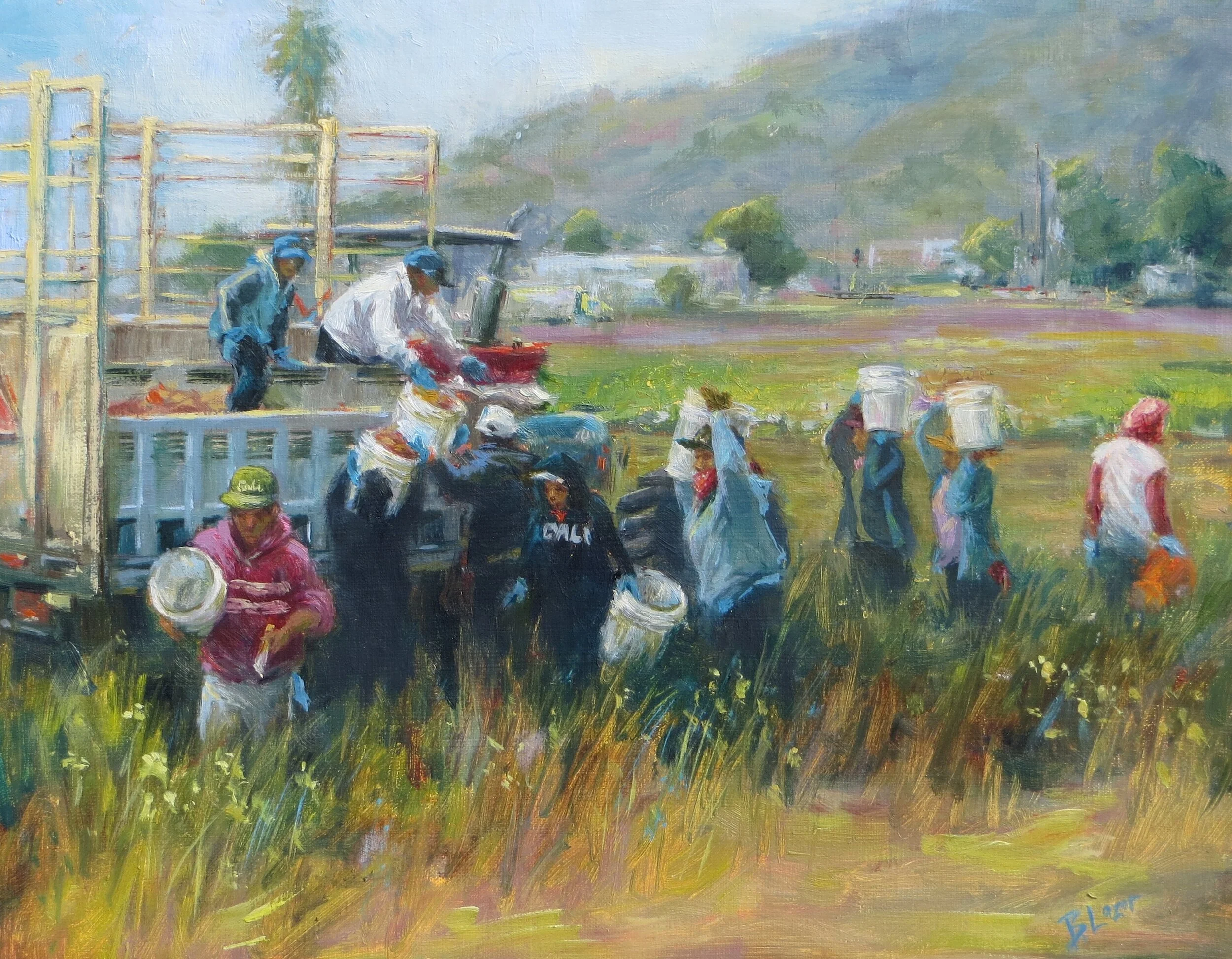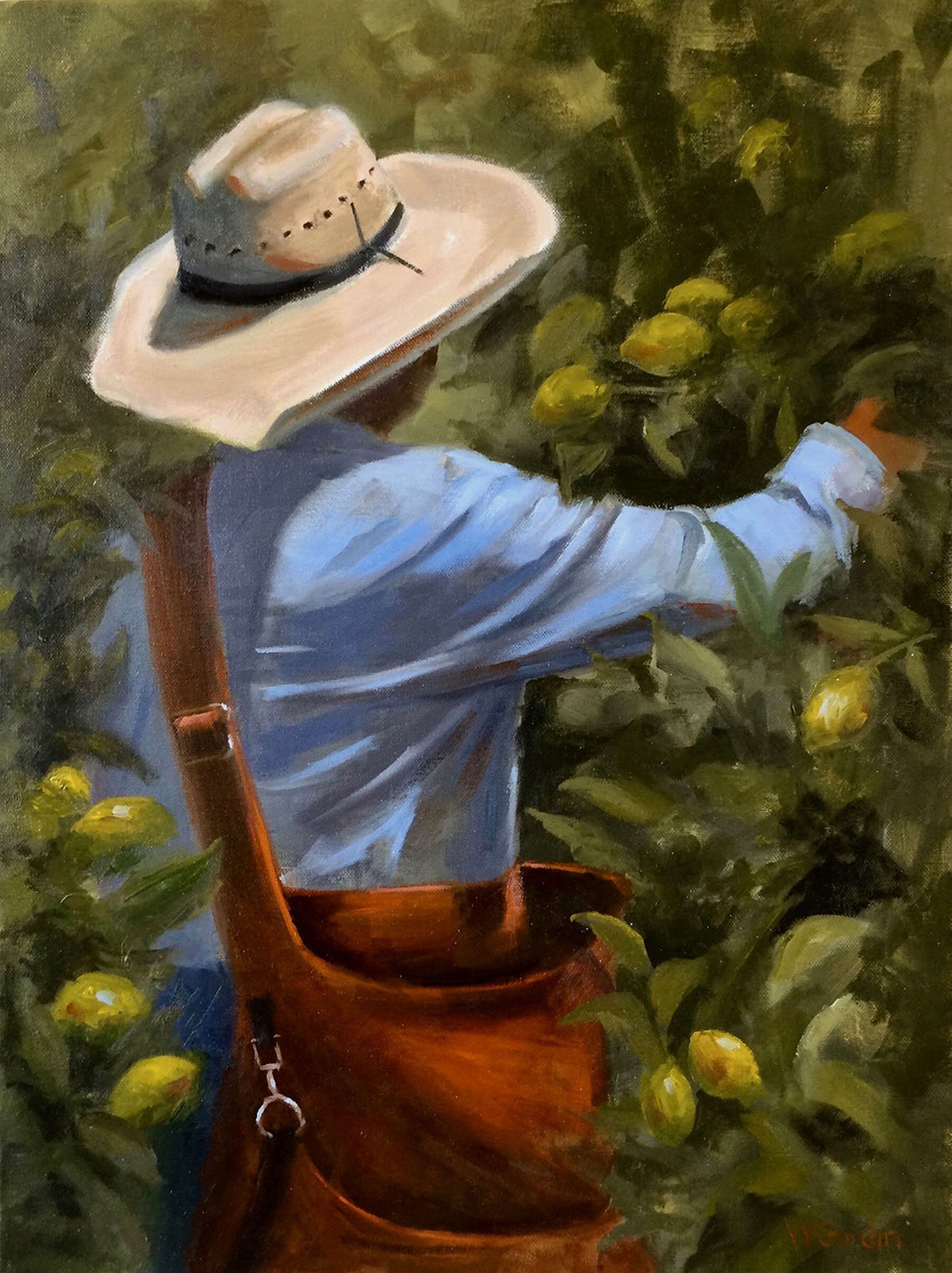2020 Art About Agriculture, Santa Paula Art Museum
By Kit Boise-Cossart
On a cloudless afternoon in late January, a small group of artists and friends gathered at the Santa Paula Art Museum to talk about their work in the 12th Annual Art About Agriculture exhibit. Co-curators, photographer John Nichols and painter Gail Pidduck, introduced and led the group through the galleries containing 67 artworks by 58 different artists.
Virginia Beale, “Flowers of Thille”
Handsomely matted and framed, “Pump House,” a small gouache by Nina Warner was inspired by her passage through the Salinas Valley. She noticed the apparent care in which the little house had been constructed and was inspired to honor the attention to detail put forth by those who made it. “It has dignity and beauty,” she said.
Photographer Marcy Belton’s first ‘aha’ moment came while driving by a pile of irrigation pipes in the Santa Clara River Valley. She photographed the pipes for hours exploring shapes, shadows and the visual interplay of the monochromatic silvery pipes. Later in her studio, working with a computer program to colorize the photos, she was able to reveal a stunning interplay of color—the result shown in her photograph “Field Pipes.”
ABOVE LEFT: Wendy Gordin, “The Lemon Picker” RIGHT: Marnie Piuze, “Fruit Valley”
Wendy Gordin lives in a lemon grove. She paints portraits of the workers who pick the fruit with “nice collared shirts” and hard work. Her unique sensibility emerges in her oil on canvas, “The Lemon Picker.”
Oxnard resident Gabriel Islas, fresh from art school in San Francisco, painted his work, “Day’s End,” from photos of a cultivated field nearby an historic adobe. “Day’s End” is washed by evening light and shadow with the Topa Topa range in the distance. Islas pushed the color contrasts to get at the “golden moments” he craves.
Gabriel Islas, “Day’s End”
Doris Kleemann-Fischer, “Cornucopia”
The sculpture “Cornucopia” by Doris Kleemann-Fischer was made from dried wild cucumber seedpods and whole eggshells. With no image in mind, she played off the shape of the pods, attaching them to a wire framework mounted on an old barn wood beam. “Nature provides us an opportunity to grow food,” she said—that idea suggested to her the delicate horn with empty eggs nestled within.
Bob Hernandez was “one of those workers as a small child working in the fields” in the Central Valley. Hernandez studied at Cal Arts and spent 25 years as a designer. Now retired, he finds artistic freedom in the gratification of mixing colors and what they do, as joyfully presented in a large acrylic titled “Farmhouse.”
Ray Harris also labored in the fields as a young boy. Recently, he reworked a 35-year-old portrait painting, “Foreman Joe.” He added work gloves to the figure and more depth to the sky, giving the work new life.
ABOVE LEFT: Susan Petty, “Habitat” RIGHT: Ray Harris, “Foreman Joe”
Sculptor Duane Dammeyer’s limestone, steel, alabaster and serpentine piece, “Citrus Procurement Specialist,” happily rebrands an orchard worker’s job description. Dammeyer admitted that he strayed from his abstract stonework with a new twist on picking fruit sans tree. A small figure is suspended in space on a leaning ladder holding an elevated single fruit, with no tree in sight.
Artist Cal Tabuena-Frolli, a farm worker’s son and journalist by trade, created a double-sided, free-standing, hand drawn map of California. The back is generously filled with text detailing the state’s agricultural products and punctuated with numerous illustrations organized into long newspaper-like columns.
John Robertson’s 6 x 6-inch oil on panel, “Produce,” is a departure from his well-known work in large-scale paintings of sports figures, created from memory. “Produce” evokes an intimate take on field cultivation and elicits a feeling of the “power of the small,” said Robertson.
John Robertson, “Produce”
Dorothy Orr, “Late Day Saunter… Poncho and Dallas, 2019”
“Late Day Saunter … Poncho and Dalles,” a watercolor on paper by Dorothy Orr, of one of the artist’s favorite go-to locations in the countryside. Painting late in the day, set up in the shade of a tree on a local back road, a long-shadowed scene unfolded. Orr captured the landscape in delicate, soft colors and textures. She felt the composition was almost complete but lacked something. Alongside a wire fence two local horses came into view, and Orr completed her composition.
Susan Petty painted her large oil on canvas “Habitat” on the ranch where she lives. Over six weeks, she studied the tangle of sunflowers, wild radishes and clover, depicting the scene in patterns that lean toward the artwork of the Arts & Crafts movement of the late 1800s. Petty noted the importance of cover crops, like those depicted in her oil, ones that conserve water plus provide habitat for a variety of species.
Lynn Hanson, “Gleanor”
In “Gleaner,” Lynn Hanson, overlays a crow on a 1901 map of Ventura published by the U.S. Department of Agriculture. Hanson collects “good historic maps that are in bad shape,” primarily old soil maps and those of national parks. Her thoughts on the gleaning of unharvested agricultural waste, something only crows do now, reflects the history of agricultural practices from Biblical times. Hanson touches on Millet’s 1857 painting of peasant women in “Gleaners,” but references modern day concerns.
Marcy Belton, “Green House Pipes”
Kit Boise-Cossart, “Road to Salinas”
Didi Martin, “Unexpected Beauty”
Patti Handfinger, “Tomato Summer”
Michelle Prebble, “Pollinator”
The12th Annual Art About Agriculture exhibition is on view November 9, 2019 to March 8, 2020 at the Santa Paula Art Museum.
COVER IMAGE: Beverly Lazor, “Back Breaking”









